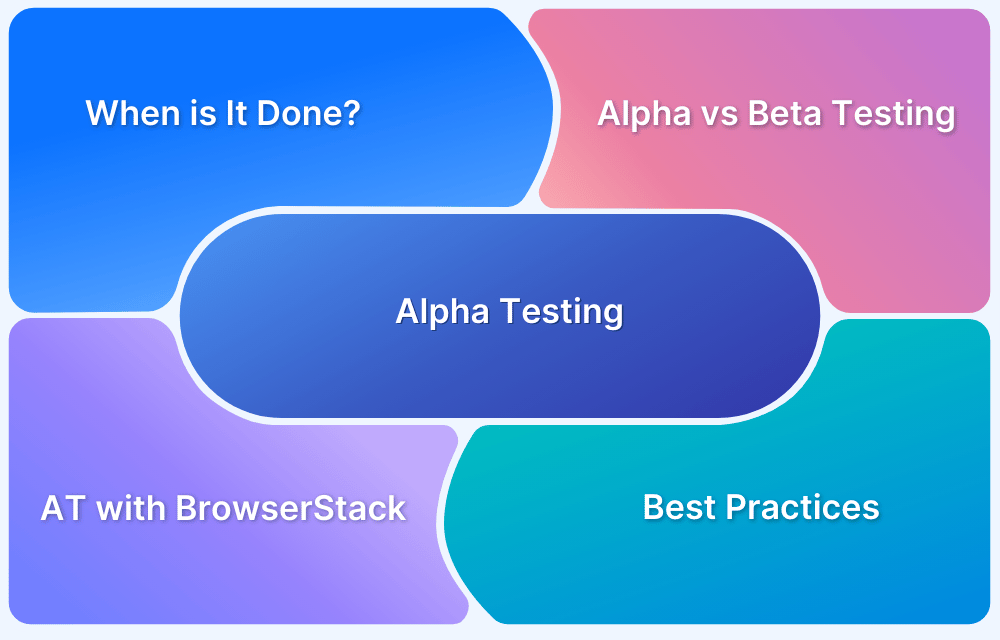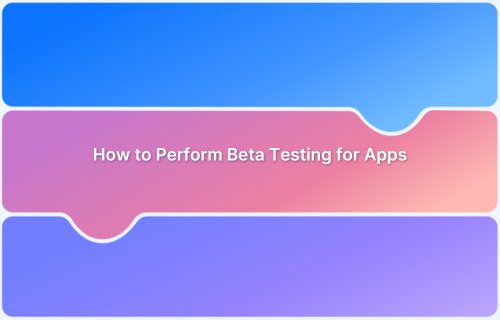Alpha and Beta testing are two stages of software testing that help identify issues and gather feedback before a product goes live. They ensure the software is stable, functional, and user-ready.
Overview
Key Points About Alpha Testing
- Goal: Detect bugs and fix issues before external release
- Who performs it: In-house QA team or developers
- Participants: Internal employees only
- Environment: Controlled lab or development environment
Key Points About Beta Testing
- Goal: Validate product performance and usability in real-world conditions
- Who performs it: Real users or selected external testers
- Participants: End users outside the organization
- Environment: Real-world settings on actual devices and networks
This article explains the difference between alpha and beta testing, including their objectives, advantages, and disadvantages.
What is Alpha Testing?
Alpha Testing is the first phase of user acceptance testing that the internal team performs before the software is released to external users. It is conducted in a controlled environment to find bugs, verify core functionality, and ensure the application meets its intended requirements.
Objectives of Alpha Testing
Below are the key objectives of alpha testing.
- Identify and fix bugs or defects early in the software development cycle.
- Validate core functionality and ensure the software meets initial requirements.
- Ensure the product works as expected in a controlled environment.
- Improve product stability by detecting issues before external testing begins.
- Gather feedback from internal stakeholders to refine features and design.
Advantages of Alpha Testing
Some advantages of Alpha testing are:
- Early Issue Detection: Key problems are identified early, reducing the risk of discovering critical issues later in the software cycle.
- Improved Problem Resolution: Developers can promptly find and fix issues, enhancing product quality and reducing rework.
- Performance Insights: Alpha testing provides valuable insights into the software’s performance and behaviors in a controlled environment.
- Enhanced Collaboration: Close cooperation between testers and developers speeds up problem resolution and fosters teamwork.
- Cost Efficiency: Catching and fixing issues early in alpha testing saves costs by minimizing costly fixes in later stages.
- Prepares for Beta: By stabilizing the product, alpha testing builds a stronger foundation for the beta phase and a smoother overall release.
Limitations of Alpha Testing
Some limitations of Alpha testing are:
- Artificial Testing Environment: Results may vary from real-life usage due to controlled, non-realistic conditions.
- Limited User Diversity: The small testing group may lack diverse perspectives, limiting insight into varied user experiences.
- Incomplete Defect Detection: Alpha testing may not catch all issues or subtle bugs that surface under diverse real-world scenarios.
Read More: Defect Management in Software Testing
- Resource Intensive: Requires significant developer involvement, time, and resources to identify and fix issues at this stage.
- Limited Scalability: Testing is often limited to a specific setup, which may not reveal how the software performs at scale.
- Feature Restrictions: Early software versions may lack all planned features, so feedback may not cover the full product experience.
Entry and Exit Criteria of Alpha Testing
There are rules for entering and leaving the alpha testing phase.
- The entry requirements are the finalization of the software’s development, the implementation of the essential features, and the completion of any required internal testing.
- Exit criteria are typically set in terms of a predetermined level of stability, the resolution of critical problems, and the stakeholders’ endorsement.
What is Beta Testing?
Beta Testing is the final stage of user acceptance testing conducted by real users outside the development team. It takes place in real-world environments to evaluate the software’s performance, usability, and reliability. Feedback from beta users helps uncover any overlooked issues and ensures the product meets user expectations before its official launch.
Objectives of Beta Testing
Below are the key goals of beta testing.
- Collect feedback from real users to assess the product’s usability and performance.
- Identify and resolve any issues that were not detected during Alpha testing.
- Ensure the product works seamlessly in real-world conditions across different devices and networks.
- Verify the product’s compatibility with a wide range of user environments.
- Improve product quality by addressing issues and suggestions before final release.
Advantages of Beta Testing
Some advantages of Beta testing are:
- Real-World Feedback: Allows developers to gather valuable input from diverse users before public release.
- Quality Improvement: Reveals how the software functions in actual usage, helping to identify and fix any remaining issues.
- User Interaction Insights: Provides data on how users interact with the software, highlighting potential usability improvements.
- Compatibility Checks: Tests compatibility with various systems and devices, ensuring a smoother user experience.
- Uncovered Use Cases: Engaging external testers can reveal use cases and perspectives missed during development.
- Reduced Post-Launch Issues: Helps to catch and resolve bugs pre-launch, reducing the likelihood of costly fixes after release.
Limitations of Beta Testing
Some limitations of Beta testing are:
- Limited Sample Representation: Feedback from a small group may not reflect the broader user population’s views and needs.
- Hidden Issues: Not all issues are revealed, and some bugs may only appear when the product is widely used post-launch.
- Time-Intensive Feedback Management: Managing and acting on feedback from many testers can be time-consuming and challenging.
- Bias in User Feedback: Feedback can be biased toward specific use cases, potentially overlooking other key aspects.
- Potential Delays: Addressing feedback may delay the final release, especially if significant changes are needed.
- Unpredictable User Behavior: Real-world users may not use the software as expected, leading to unpredictable results and issues.
Entry and Exit Criteria of Beta Testing
Here’s when to enter or exit Beta testing.
Entry Criteria
- The software has passed Alpha testing and is feature-complete.
- Known critical and major bugs are resolved, and the product is stable.
- A defined plan and infrastructure for collecting user feedback are in place.
Exit Criteria
- All critical and major issues identified during beta testing have been resolved.
- User feedback has been reviewed and incorporated where applicable.
- The product meets the performance and usability standards defined for beta testing.
Read More: Top 15 Beta Test Tools
Alpha vs Beta Testing: Comparison
Alpha testing is internal and is performed by the development team to focus on stability, functionality, and code reliability. On the other hand, beta testing is external and involves real-world users who focus on usability and the overall experience.
Here is a table highlighting the key differences between alpha and beta testing.
| Criteria | Alpha Testing | Beta Testing |
|---|---|---|
| Testing perspective and focus
| Testing internally and focusing on stability & functionality | Testing externally and focusing on the entire user experience and usability |
| Test case design | Developers design the test cases | Both designers and developers design the test cases |
| Knowledge of internal code details | Testers get knowledge of the internal code details | Testers get minimal knowledge of the internal code details |
| Testing approach | The development team conducts the testing process | External testers and end users conduct it |
| Test coverage | Limited coverage | Broad coverage |
| Test case independence | Very limited independent test cases | More independent test cases |
| Skill requirements | Strong technical skills required | Understanding of end user perspective required |
Similarities between Alpha and Beta Testing
Although Alpha and Beta testing have different phases, they share several key characteristics to support product readiness.
- Product Readiness: Both help verify that the software meets requirements and is ready for launch.
- Report Issues and Feedback: Both require testers to report bugs and share feedback for further improvements.
- Support Quality Goals: Both contribute to ensuring that the final product meets functional and user expectations.
Perform Testing on Real Devices With BrowserStack
BrowserStack is a cloud-based testing platform that allows you to test your application on 3,500+ real devices and browsers. This helps verify your app’s performance under real user conditions.
Key features of BrowserStack for testing:
- Real Device Cloud: Test on various real Android, iOS, Windows, and macOS devices.
- Cross-Browser Testing: Access a wide range of browsers, including Chrome, Edge, Safari, IE, and Firefox.
- Native Features: Test how your app works with native features like camera, microphone, screen readers, GPS, and more.
- Real-time Debugging: Debug your application on mobile and desktop browsers using developer tools.
- Local Testing: Securely test your website hosted on internal networks, behind proxies, and firewalls.
Conclusion
Alpha and Beta testing are essential to ensure software quality and meet user expectations. Alpha testing focuses on early bug detection and stability, while Beta testing gathers real-user feedback to refine the product.
BrowserStack Live helps you improve your testing by giving you access to over 3,500+ real devices, browsers, and OS combinations. You can access native device features, simulate network conditions, and test websites on local & staging environments. Gain insights into the tests with BrowserStack analytics and improve overall testing efficiency.







